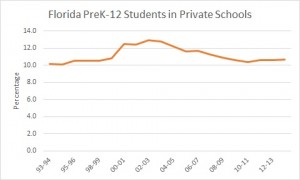The impact of scholarship programs on Florida’s private schools, recently portrayed in the Orlando Sentinel, should be seen in the context of a larger transformation of public education. It brings to mind a revealing exchange in a gubernatorial debate two decades ago.

Floridians have been debating the redefinition of public education since the ’94 gubernatorial campaign.
In that 1994 debate, the final one between Gov. Lawton Chiles and challenger Jeb Bush, moderator Tim Russert was trying to pin down the future governor on the implications of his proposed voucher plan: How would it change the ratio of students attending public schools to the students attending private ones? What did he think the ideal ratio would be?
Bush rejected Russert’s premise. It wouldn’t matter if the proportion of students attending private schools reached “50 percent” of all K-12 students, “or if it was 5 percent,” he said. He added, to applause: “We would have redefined what public education is.”
These comments have largely been lost to history, overshadowed by Chiles’ famous retort after being accused of being a liberal defender of the status quo: “Let me tell you one other thing about the old liberal. The old He-Coon walks just before the light of day.” (See the full exchange in this video excerpt.)
Ironically, though, Chiles signed a law during his second term, creating charter schools in 1996, that helped set into motion the redefinition of public education Bush had predicted.
What has gotten less attention less attention to date is that the role of private schools has since been redefined, as well.

In 1994, slightly more than 10 percent of Florida’s Pre-K-12 students enrolled in private schools; now, 10.7 percent do, a decline from an earlier peak. Source: Florida DOE.
When Russert posed his question, private schools enrolled slightly more than one in ten Florida pre-K-12 students. Today, with the growth of three private school scholarship programs and the dawn of another, the ratio is roughly the same: One in ten. Private school choice hasn’t really altered the ratio, but it has helped to change the role of private schools.
By the time Bush ran his successful second campaign in 1998, charter schools, magnet schools and International Baccalaureate programs had begun to proliferate in the public school system. As a result, public education was no longer defined solely by a system of neighborhood assignments. More and more students would choose their schools.
At the same time, the rise of new, attractive, free, publicly funded options would draw students away from private schools, and into the public system.
Private school enrollment would peak during the 2003-04 school year, when tax-credit and McKay scholarship programs were just getting started. It would never fully recover. So the role of private schools is also being redefined.
During the 1994 debate, Gov. Chiles said: “I don’t feel that you have a responsibility to put kids in private schools. I’ve had my kids in private schools before. I have paid for that. I have paid for that, and I think that’s my responsibility.”
That talking point would be echoed 20 years later, during a press conference last August announcing a lawsuit challenging the state’s largest private school scholarship program. But thanks to the tax credit scholarships, the doors to Florida’s private schools have been opened to children whose families never had the means.
As the Sentinel notes, McKay Scholarships for special needs students have helped ordinary families access facilities like the Conductive Education Center of Orlando, which offers intensive, highly specialized, expensive educational services to children with special needs. Tax credit scholarships, for their part, have enabled the growth of a new breed of private schools that also cater to low-income and working-class students. For the vast majority of the families attending these schools and others like them, these options would have been out of reach a generation ago.
The tax credit and McKay scholarships combine to account for nearly one in three private school students. But since the private school sector has shrunk over the past decade, it stands to reason that scholarships are playing an increasingly important role in it.
We can infer that private schools serve substantially more low-income students than they did before, since nearly one in five of their students pays tuition with the help of a tax credit scholarship. Nearly one in ten uses a McKay scholarship, so the same likely is true for special needs students.
Private schools are becoming more diverse. A look at the private schools that are opening, or growing, suggests their missions are becoming more diverse, as well. Consider the Notre Dame Ace Academies, or Tampa’s Academy Prep Center, which cater primarily or exclusively to students from low-income and working-class backgrounds.
The traditional model of private schooling that was built on serving families of means, with need-based financial aid to a relative handful of needier students, has not gone away. However, its share of the overall sector is shrinking.
The redefinition of public education has meant that some wealthier students who might otherwise have gone to private schools are now attending public schools – finding attractive alternatives in magnet and charter schools and IB programs.
At the same time, the redefinition of private schooling means more students who would have attended public schools are now being served by private schools. The amount of funding available for each scholarship means their education is now being provided at a lower cost to taxpayers.
The choices parents make for their children in today’s public education system defy many of the tropes from previous decades.
The redefinition of public and private schooling should trigger new debates about how new school should be financed; how students should be transported to school and by whom; how school performance should be measured; how performance data should be used, and how it should be reported to the public; how to strike the right balance between schools of choice and schools of right; how to best ensure that a new system founded on the idea of parental choice can serve of every child.
Unfortunately, the debate over private school choice program seldom delves deeply enough into these questions. We’re too busy rehashing arguments from 1994.
The tax credit scholarship program referenced in this post is administered by Step Up For Students, which co-hosts this blog and employs the author.
The post The redefinition of public – and private – schooling in Florida appeared first on redefinED.